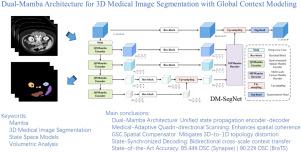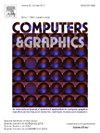DM-SegNet:用于具有全局上下文建模的3D医学图像分割的双曼巴架构
IF 2.8
4区 计算机科学
Q2 COMPUTER SCIENCE, SOFTWARE ENGINEERING
引用次数: 0
摘要
准确的三维医学图像分割需要能够协调全局上下文建模和空间拓扑保存的架构。虽然像Mamba这样的状态空间模型(ssm)显示了序列建模的潜力,但现有的医疗ssm存在编码器-解码器不兼容的问题:编码器的一维序列平坦化损害了空间结构,而传统的解码器无法利用Mamba的状态传播。我们提出DM-SegNet,一种双曼巴架构,集成了定向状态转换和解剖感知分层解码。核心创新包括一个四向空间曼巴模块,采用四向3D扫描来保持解剖空间一致性,一个门控空间卷积层,在状态建模之前增强空间敏感特征表示,以及一个曼巴驱动的解码框架,实现跨尺度的双向状态同步。对两个具有临床意义的基准进行了广泛的评估,证明了DM-SegNet的有效性:在Synapse数据集上实现了最先进的Dice Similarity Coefficient (DSC),用于腹部器官分割为85.44%,在BraTS2023数据集上实现了90.22%的脑肿瘤分割。本文章由计算机程序翻译,如有差异,请以英文原文为准。

DM-SegNet: Dual-Mamba architecture for 3D medical image segmentation with global context modeling
Accurate 3D medical image segmentation demands architectures capable of reconciling global context modeling with spatial topology preservation. While State Space Models (SSMs) like Mamba show potential for sequence modeling, existing medical SSMs suffer from encoder–decoder incompatibility: the encoder’s 1D sequence flattening compromises spatial structures, while conventional decoders fail to leverage Mamba’s state propagation. We present DM-SegNet, a Dual-Mamba architecture integrating directional state transitions with anatomy-aware hierarchical decoding. The core innovations include a quadri-directional spatial Mamba module employing four-directional 3D scanning to maintain anatomical spatial coherence, a gated spatial convolution layer that enhances spatially sensitive feature representation prior to state modeling, and a Mamba-driven decoding framework enabling bidirectional state synchronization across scales. Extensive evaluation on two clinically significant benchmarks demonstrates the efficacy of DM-SegNet: achieving state-of-the-art Dice Similarity Coefficient (DSC) of 85.44% on the Synapse dataset for abdominal organ segmentation and 90.22% on the BraTS2023 dataset for brain tumor segmentation.
求助全文
通过发布文献求助,成功后即可免费获取论文全文。
去求助
来源期刊

Computers & Graphics-Uk
工程技术-计算机:软件工程
CiteScore
5.30
自引率
12.00%
发文量
173
审稿时长
38 days
期刊介绍:
Computers & Graphics is dedicated to disseminate information on research and applications of computer graphics (CG) techniques. The journal encourages articles on:
1. Research and applications of interactive computer graphics. We are particularly interested in novel interaction techniques and applications of CG to problem domains.
2. State-of-the-art papers on late-breaking, cutting-edge research on CG.
3. Information on innovative uses of graphics principles and technologies.
4. Tutorial papers on both teaching CG principles and innovative uses of CG in education.
 求助内容:
求助内容: 应助结果提醒方式:
应助结果提醒方式:


